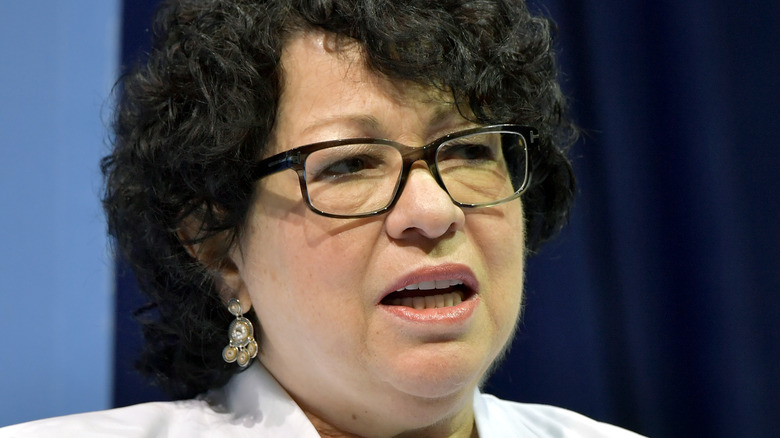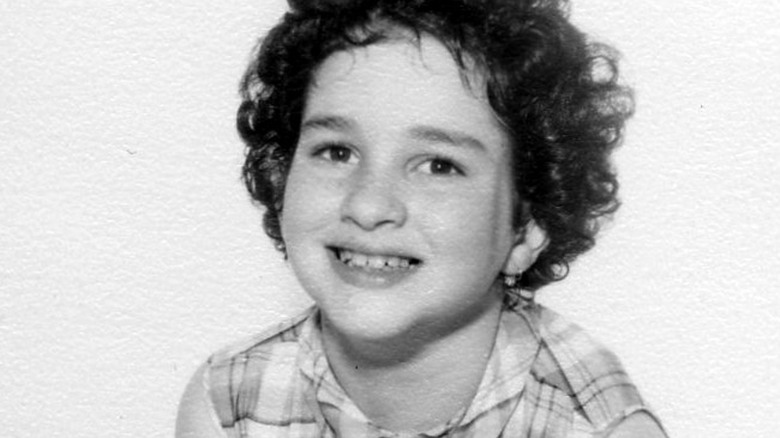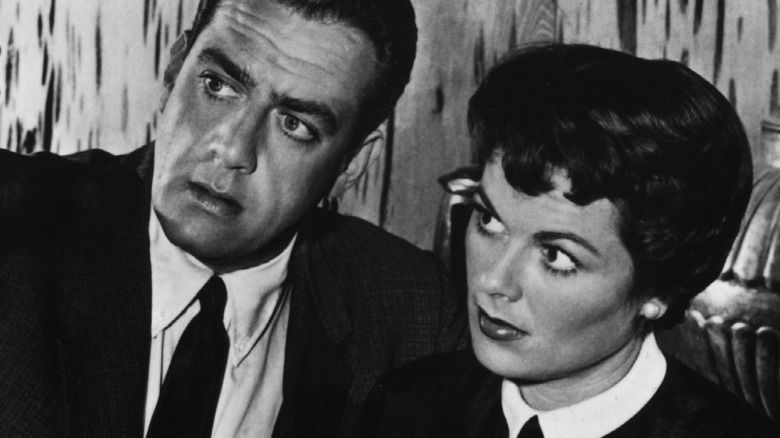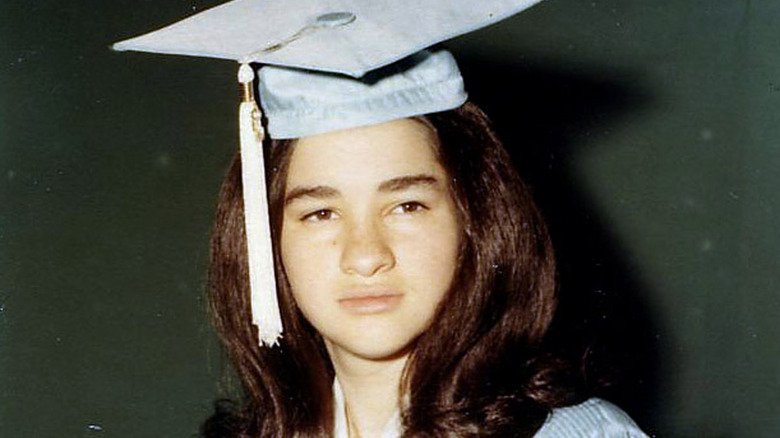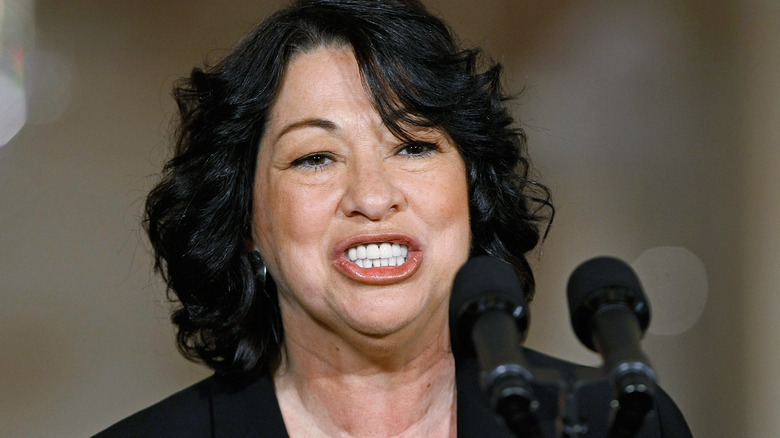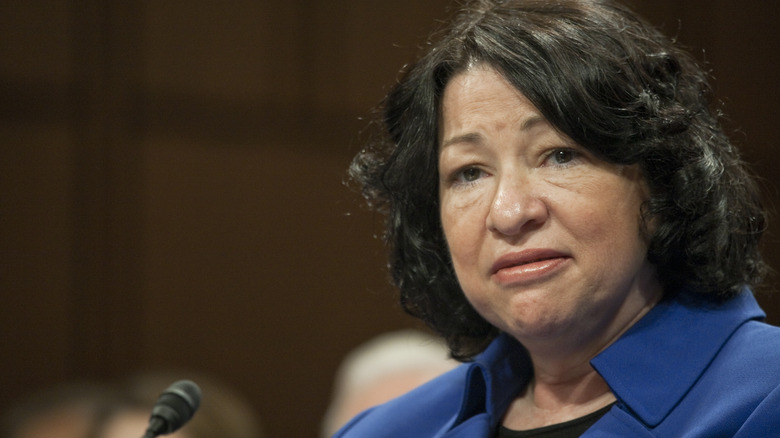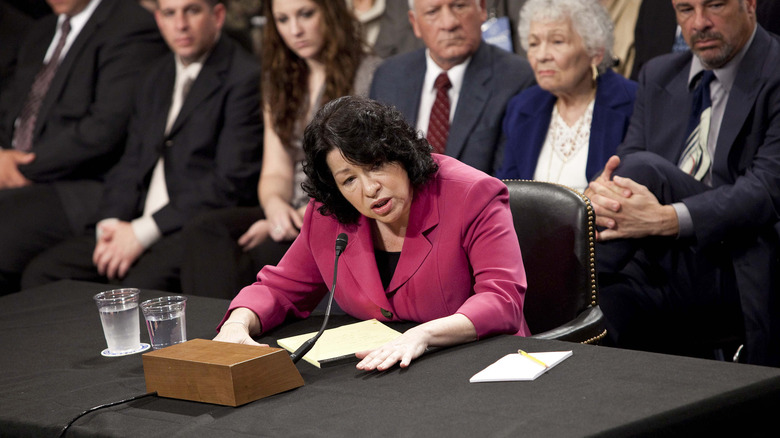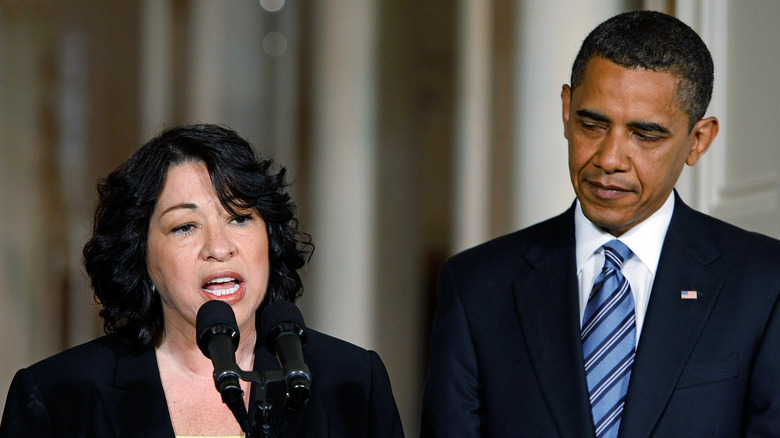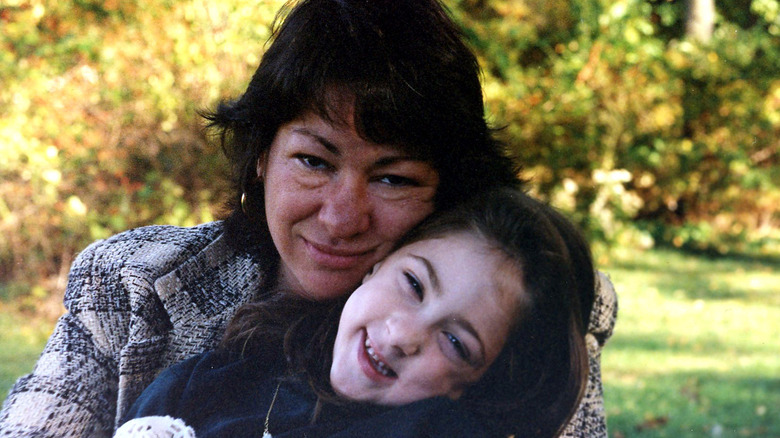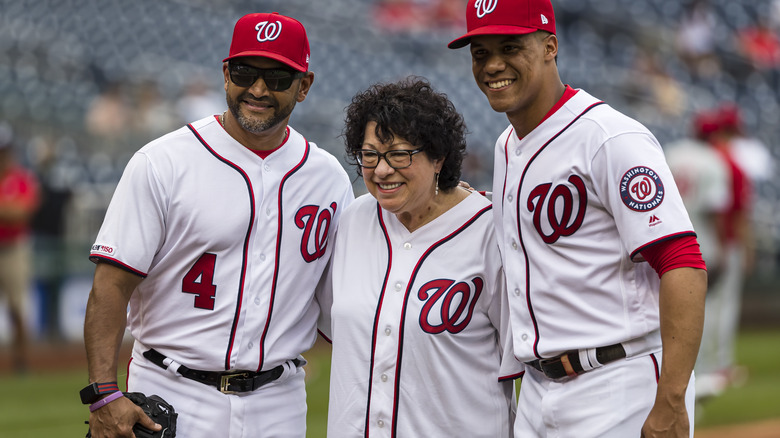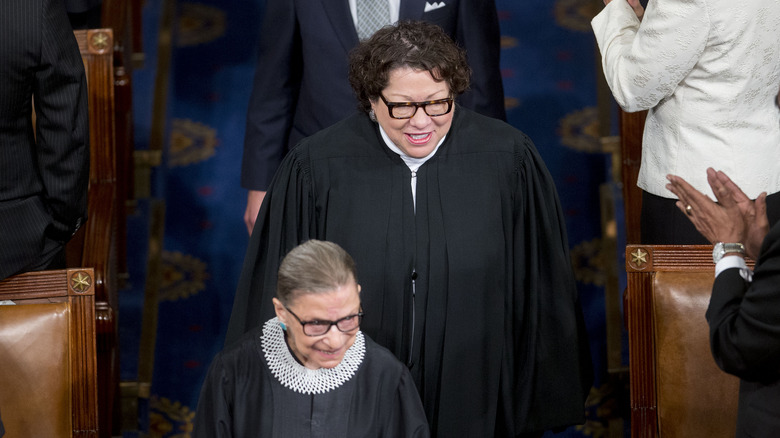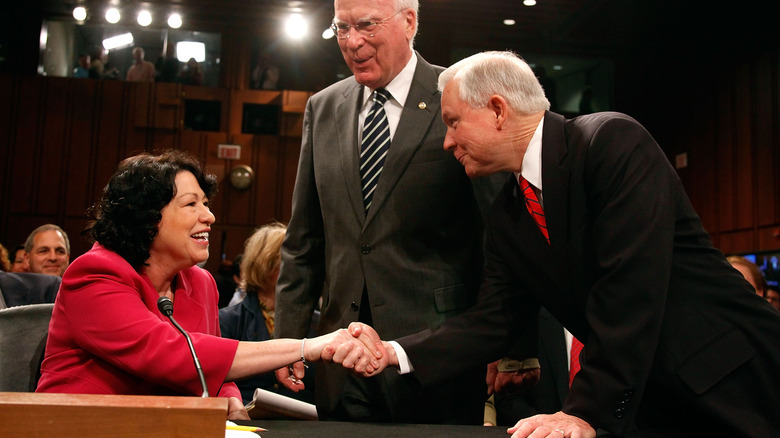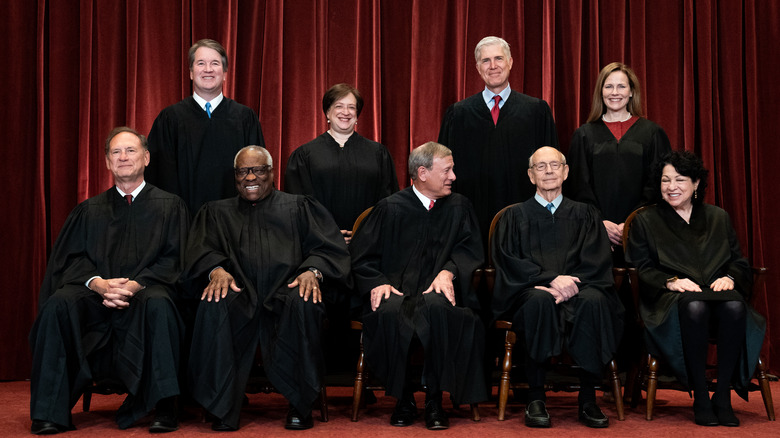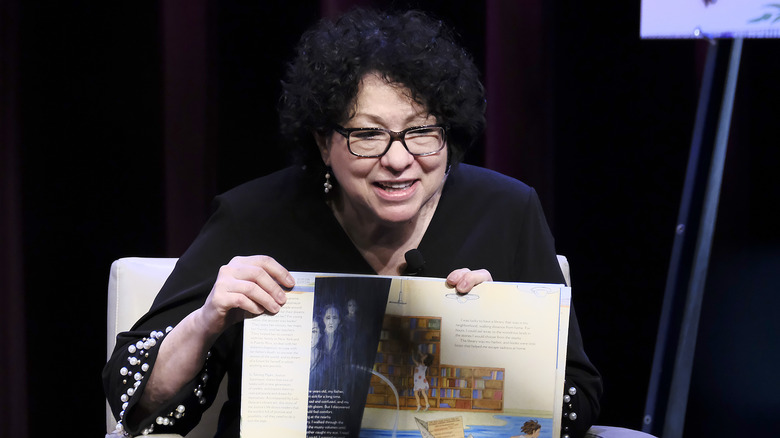What You Don't Know About Sonia Sotomayor
Sonia Sotomayor made history when she was nominated as a justice of the Supreme Court in 2009. But many people don't know how she rose from her challenging beginnings in New York to become one of the most powerful judges in America. Her parents both left Puerto Rico during World War II and settled in a housing project in the Bronx, per The New York Times, where Sotomayor's father later died when she was only nine. He had struggled with alcoholism her whole life, as she told "Today" in 2013.
"Neglect was the right word,” the judge explained, describing her difficult childhood with a mother who was often absent and unhappy. "The mother I grew up with is not the mother I know now. It's not the mother she became after my father died, and that's been the greatest prize of my life. Because in watching my mother grow and develop herself, I grew and developed myself." Keep reading to discover more about Sotomayor's astonishing journey to the Supreme Court.
She was diagnosed with diabetes at 8
When Sonia Sotomayor was diagnosed with Type 1 diabetes, the medical community had far less knowledge about the condition, which was treated almost like a death sentence. "I savor life," Sotomayor wrote in her memoir, "My Beloved World," per USA Today. "When you have anything that threatens life ... it prods you into stepping back and really appreciating the value of life and taking from it what you can." While her mother and grandmother were distraught by the news, the illness gave the 8-year old a drive that never left her.
As she explained to NPR, diabetes still affects her life as an adult. Telling a story where Justice Sotomayor was in a restaurant bathroom "giving herself an insulin injection," she recalled a woman walking in and seeing her putting the injection away after finishing administering it to herself. "As I was leaving the restaurant, I walked past her and heard her say to her friend, she's a drug addict," she remembered. Sotomayor declared, "Madam, I am not a drug addict. I am diabetic, and that injection you saw me give to myself is insulin. It's the medicine that keeps me alive."
She was interested in law because of Perry Mason
When Sonia Sotomayor was growing up in the Bronx, she had two fictional heroes that would shape the course of her life. "When I was young I wanted to be a detective, like Nancy Drew," she later revealed in an interview on "Good Morning America," describing how the teen sleuth prompted her to explore the world of crime-solving. As Sotomayor told NPR, Nancy Drew became her idol because "she had character, and she had courage."
There was one problem with her dream job, however. After Sotomayor had been diagnosed with Type 1 diabetes, her doctors informed her that she would never be able to become a cop when she grew up, due to her disease. "I couldn't be a cop," she recalled in an interview with CBS, adding that TV gave her an alternative career path. "I figured out very quickly, watching "Perry Mason," that I could do some of the same things by being a lawyer." The classic legal drama, which starred Raymond Burr, inspired her to set her sights on the courtroom – and the young Sotomayor never looked back.
She was a fish out of water at Princeton
Sonia Sotomayor may have been a promising young student, but as she wrote in her autobiography "My Beloved World," she didn't even know what the "Ivy League" was when she started applying to schools. Despite that slight hiccup, she was accepted into Princeton, an unexpected achievement for someone from her Catholic high school. Per Life, Princeton had only begun admitting women for the first time in 1969, three years before Sotomayor would arrive. So her presence as a Hispanic female student from the Bronx was groundbreaking, even if it also left her feeling out of place.
In "My Beloved World," Sotomayor revealed that she wasn't familiar with a lot of the traditions of an Ivy League college. When she received an invitation from Phi Beta Kappa, the law student threw it away, assuming that it was "just junk mail from some club" and that they were trying to scam her out of money. A friend had to tell her that it was a real sorority, insisting that Sotomayor accept the prestigious invitation. She also received the Pyne Prize without knowing that it was the highest possible distinction that a graduating senior could receive from Princeton.
She helped convict the 'Tarzan Burgler'
Sonia Sotomayor's career in law began in New York City, where she started working as an assistant district attorney in 1979. Crime rates in the city had skyrocketed: as The New York Times reported, 1980 was judged to be the worst year of crime in the history of the city, with more than 1800 homicides. And between 1981 and 1982, the inhabitants of Harlem were targeted by Richard Maddicks, who was nicknamed the "Tarzan Burglar" for his ability to swing through windows and across rooftops. Per NPR, he was responsible for more than 20 burglaries and had murdered three victims by the time he was caught.
Sotomayor was assigned the Tarzan Burglar case alongside Hugh Mo, a more experienced prosecutor from her office. "She had that uncanny ability of putting together a complicated set of facts and distilling them into a very simple story that would resonate with the jury," Mo told NPR. "That's unusual for a young attorney." Despite her inexperience, Sotomayor was allowed to present the case in court. She also managed to successfully persuade the court to convict Maddicks, who received a sentence of 62 years to life. Sotomayor also went on to prosecute "the first child pornography case under a new New York statute," making a name for herself on high-profile cases.
She quit being a felony prosecutor out of exhaustion
After five more years as a felony prosecutor, Sonia Sotomayor began looking for another position. She worried that she was becoming too cynical, thanks to a job that asked her to look for the worst in everybody. "I could see the signs that I too was hardening, and I didn't like what I saw," the judge wrote in "My Beautiful World," describing how her outlook began to change. "Even my sympathy for the victims, once such an inexhaustible driver of my efforts, was being depleted by the daily spectacle of misdeeds and misery."
”After a while, you forget there are decent, law-abiding people in life,” the judge revealed to The New York Times in 1985. During her last few cases in the district attorney's office, she noticed that a man involved with a gun possession charge seemed familiar. "So I looked at his sheet and, sure enough, he was one of the first defendants I had had," Sotomayor noted, reflecting on how cycles of criminal behavior never seemed to stop. And as she later told The New York Times, conflict in the Hispanic community particularly troubled her. "The saddest crimes for me were the ones that my own people committed against each other," Sotomayor admitted, describing how she was emotionally affected by everything that she witnessed.
She was first nominated by a Republican
Despite her left-wing credentials, Sonia Sotomayor was first nominated as a judge by a Republican president. Her childhood dream, which she had fostered while watching "Perry Mason," was fulfilled when George H.W. Bush appointed her to the federal bench in 1991.
As the Washington Examiner observed, the choice may have been made more by a New York Democrat, Senator Daniel Moynihan. He had a secret arrangement with the Republican senator Alphonse D'Amato, who allowed him to pick one out of every four district court seats. This bi-partisan deal led to Sotomayor rising through the ranks and being nominated by Bush. Years later, when Barack Obama nominated her to the Supreme Court, Bush also defended her from accusations of racism. After Sotomayor suggested that a "wise Latina woman" might be just the right person to make wise judicial decisions, conservatives like Rush Limbaugh and Newt Gingrich called her statement "reverse [racism]."
"That's not right. I mean, that's not fair," Bush told CNN at the time, per Politico, criticizing the right-wing backlash to her nomination. "It doesn't help the process. You're out there name-calling. So let them decide who they want to vote for and get on with it."
She set a lot of milestones
Sonia Sotomayor's arrival on the highest federal court in the United States was a landmark achievement, but during the selection process, the judge wasn't sure whether she really stood a chance.
As The Washington Post reported in 2009, Sotomayor was the first Hispanic justice to ever serve on the Supreme Court, as well as being only the third woman. She received her fair share of criticism after the potential nomination was announced, as she later told Gloria Estefan on "Red Table Talk" on Facebook, and had even worried whether she had been shortlisted as a publicity stunt. "I didn't actually believe that President Obama was going to pick me," the judge recalled. "Everyone else that was on his shortlist had been interviewed, and I wasn't being interviewed. I thought 'Gee, maybe I'm just there for show.'"
When Sotomayor finally received the phone call from Barack Obama, she was overwhelmed. "At that moment, my heart started to thump, and within seconds the president of the United States gets on and says, 'I have decided that I would like you to be my nominee to the United States Supreme Court,'" the judge remembered, adding that she cried during the call. "Judge, you don't have to cry," Obama reportedly told her. "I'm putting together the best team to get you through this confirmation process."
She divorced her childhood sweetheart
According to The New York Times, Sonia Sotomayor married Kevin Noonan, a biologist and patent lawyer, as soon as she had graduated from Princeton in 1976. Although the pair had been dating since high school, their marriage only lasted until 1983, when they amicably divorced. As of this writing, Sotomayor hasn't been remarried since Noonan.
"I was completely consumed with work when I started as a D.A. in Manhattan, and I really wasn't paying attention to him," she told Oprah Winfrey in a 2013 interview on "Oprah's Next Chapter." "I take full responsibility for that part of the end." Noonan also had his own insecurities, as she revealed. "He began to fear not being as successful as I," Sotomayor admitted. "He said, 'One day I woke up realizing that no matter how hard I worked, I might not be as successful as you.'"
As she confessed, that was a "difficult issue" for both of them to address. "I loved him," Sotomayor reflected. "And I knew he loved me. But did I need him in the way that he wanted me to need him? He was probably right that I didn't."
She's a big fan of baseball
During her years in New York, Sonia Sotomayor gained a reputation as the judge who saved baseball.
According to Forbes, a dispute between the sport's owners and players had been brewing for years. Plans to cap the wages of players had been announced, leading to a 232-day strike and a canceled season. By 1995, it looked like replacement players were going to start a new season, replacing the striking baseball players who had unsuccessfully tried to get then-president Bill Clinton to intervene. Fans were devastated and didn't show up to any of the training games, which usually attracted large crowds.
On March 30th, however, Sotomayor ended the historic baseball strike by ruling against the MLB and issuing an injunction. "I hope none of you assumed ... that my lack of knowledge of any of the intimate details of your dispute meant I was not a baseball fan," she told both sides during the court case, per Time. "You can't grow up in the South Bronx without knowing about baseball."
She was very close to Ruth Bader Ginsburg
Ruth Bader Ginsburg was the second female judge to take her place on the Supreme Court, paving the way for Sonia Sotomayor. The pair bonded after Ginsburg's beloved husband Martin died in 2010, as Sotomayor's biographer Joan Biskupic recorded in "Breaking In."
At her first end-of-term party, Sotomayor convinced the other Supreme Court judges to salsa dance with her. While most joined in with the festivities, an exhausted Ginsburg refused, since it had only been a few days since her husband's death. Sotomayor leaned in and whispered that "[Marty] would have wanted her to dance," however, so Ginsburg joined her for "a few steps" in front of their makeshift audience. Afterward, she held Sotomayor's face in her hands and sincerely thanked her.
After RBG died in 2020, Sotomayor paid tribute to her in a touching statement to NBC, revealing that the judge had "welcomed me to the Court with a warmth I could not have expected," adding that she felt "a special kinship" with Ginsburg. "She was someone whose wisdom, kindness, and unwavering support I could always rely on. I will forever cherish the moments we shared," Sotomayor continued, adding that she "will miss Ruth greatly."
Her ideas about the Constitution have faced interrogation
Sonia Sotomayor's beliefs have come under scrutiny since she first entered the public eye. In particular, she's always been interrogated over her judicial philosophy about the interpretation of the Constitution. Sotomayor has been referred to as a "legal realist," as The Wall Street Journal reported, which means that she doesn't treat the law like an unchangeable exact science, but as something that bends "to the realities of ever-changing social, industrial and political conditions." She supports an interpretation that allows for empathy and reflects a judge's personal values, a philosophy that Jeff Sessions questioned in 1997, per HuffPost.
Sotomayor faced off against the Republican while she was up for a position in the United States Court of Appeals: before she could be considered, the judge had to defend how she felt about the Constitution. When Sessions asked whether she agreed that the Constitution had to be fully enforced, Sotomayor replied: "Sir, I do not believe we should bend the Constitution under any circumstance. It says what it says. We should do honor to it."
He also pushed her on sentencing guidelines, which she had previously criticized as too harsh in one particular case. "I do agree, however, that great respect both for the law and for the process is terribly important," Sotomayor argued (via PBS). "And as I underscored there, I do what the law requires and I think that is the greatest respect I could show for it."
She contradicted her fellow judges over Trump's policies
The Supreme Court judges don't always come to a unanimous conclusion. And Sonia Sotomayor hasn't been afraid to dissent from some official rulings over the years, especially when it came to Donald Trump's administration.
When the Republican fought to impose a travel ban on several Muslim majority countries, Sotomayor broke from her fellow judges and condemned the case. "How could the Government successfully claim that the Proclamation rests on security needs if it is excluding Muslims who satisfy the Proclamation's own terms?" she argued, according to Global Citizen. "Our Constitution demands, and our country deserves, a Judiciary willing to hold the coordinate branches to account when they defy our most sacred legal commitments. Because the Court's decision today has failed in that respect, with profound regret, I dissent."
And when Trump kicked off a series of federal executions at the end of his presidency, Sotomayor condemned the Supreme Court for facilitating these deaths. "After seventeen years without a single federal execution, the Government has executed twelve people since July," she wrote, per Slate, pointing out that the Federal Government had now "executed more than three times as many people in the last six months than it had in the previous six decades." She added, "Throughout this expedited spree of executions, this Court has consistently rejected inmates' credible claims for relief."
She's also a children's author
Although Sonia Sotomayor receives a salary of $200k as a Supreme Court justice, according to Celebrity Net Worth, she has also added to her net worth of $6 million by writing several children's books. As she told NPR, however, there's another reason these books are close to her heart.
"I wanted to talk about children like me," Sotomayor revealed, discussing how books like "Just Ask!" feature all kinds of chronic conditions. As well as her own diabetes, the judge wrote about children with "attention-deficit/hyperactivity disorder, autism, blindness and Down syndrome," according to AP, working together on a garden. "Differences provide not just beauty in life, but they're important to the quality of the world we live in," Sotomayor continued, adding that the world is "richer" because of diversity. "We're not lesser because of it. We're stronger because of it. My book celebrates the many ways in which kids and adults are different and do things differently."
The judge also explained how much she cares about inspiring young children. "I truly believe that if I can inspire the younger generation to see themselves as positive agents for change...that I will leave a more lasting legacy than what I can do as a judge," Sotomayor insisted.

